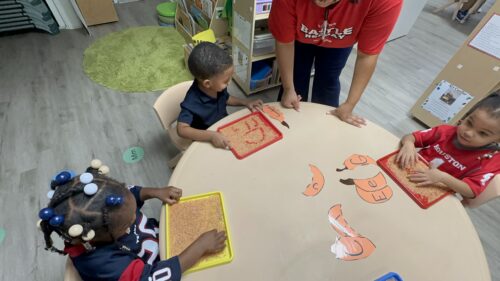One of the most powerful tools in early childhood education is something every child already owns is their name. At Collaborative for Children, we use name recognition as a gateway to literacy, helping children connect emotionally and cognitively to the learning process. Research shows that children who start with their name learn letters faster and retain them longer.

Our Child Care Centers of Excellence are built around personalized learning. Educators use each child’s name as an anchor word to introduce letters, sounds, and writing. This approach taps into emotional engagement, which neuroscience confirms activates multiple areas of the brain.
When a child sees their name on a cubby, a worksheet, or a classroom label, they feel ownership. That emotional connection boosts memory, attention, and motivation. It’s not just about learning letters, it’s about building confidence and a sense of belonging.
Collaborative for Children’s certified early childhood education (ECE) curriculum integrates name-based learning into daily activities. Children trace, write, and identify the letters in their name using tactile materials like sandpaper letters, puzzles, and finger-tracing trays. These multi-sensory experiences reinforce phonics, letter formation, and sound awareness.
For example, a child named Emma learns that letters have shapes, sounds, and order. She sees that two M’s repeat, and that written symbols match spoken language. This foundational understanding accelerates reading readiness.
Our STEAM curriculum (Science, Technology, Engineering, Arts, and Math) includes literacy-focused play that centers around each child’s identity. Activities like “Name Letter Hunts” and personalized storybooks make learning fun and meaningful. Children search for the letters in their name across books, signs, and classroom materials—turning everyday moments into literacy lessons.
This approach works especially well for bilingual and neurodiverse learners. Because name-based learning is emotionally meaningful, it transcends language barriers and supports diverse cognitive styles.
If you want your child to start reading with confidence, choose a child care center that sees them as more than a student. Collaborative for Children’s Centers of Excellence use certified ECE curriculum, STEAM learning, and personalized literacy strategies to help every child thrive.
Find the Best Child Care NowWhy is name recognition important for early literacy?
Name recognition creates emotional engagement, which boosts memory and attention. It helps children learn letters faster and builds a strong foundation for reading.
How does Collaborative for Children use name-based learning?
We use each child’s name as a starting point for teaching letters, sounds, and writing. Our curriculum includes multi-sensory activities that reinforce literacy through identity.
Can name-based learning help bilingual children?
Yes. Emotional connection to a child’s name activates brain regions that support learning, regardless of the language spoken at home.